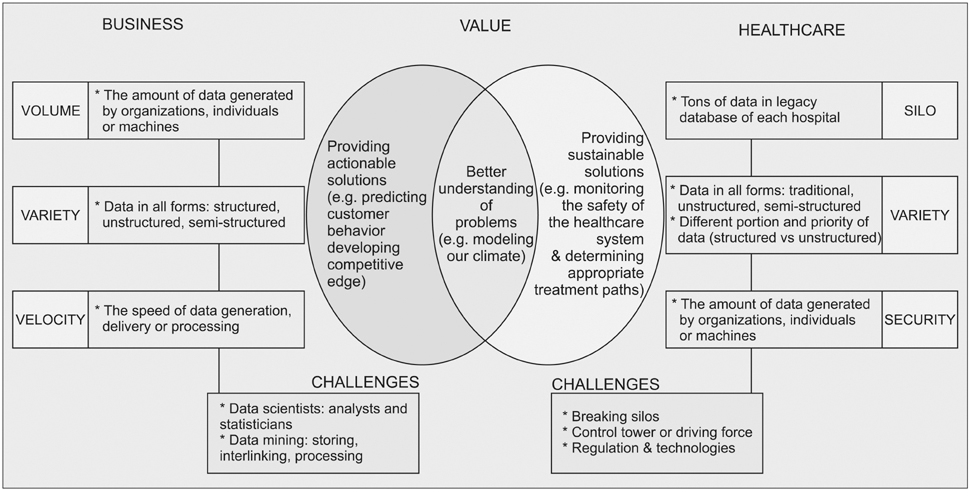Healthc Inform Res.
2013 Jun;19(2):79-85. 10.4258/hir.2013.19.2.79.
Potentiality of Big Data in the Medical Sector: Focus on How to Reshape the Healthcare System
- Affiliations
-
- 1Creative Future Research Laboratory, Electronics and Telecommunications Research Institute (ETRI), Daejeon, Korea. ironhoon@etri.re.kr
- KMID: 2229488
- DOI: http://doi.org/10.4258/hir.2013.19.2.79
Abstract
OBJECTIVES
The main purpose of this study was to explore whether the use of big data can effectively reduce healthcare concerns, such as the selection of appropriate treatment paths, improvement of healthcare systems, and so on.
METHODS
By providing an overview of the current state of big data applications in the healthcare environment, this study has explored the current challenges that governments and healthcare stakeholders are facing as well as the opportunities presented by big data.
RESULTS
Insightful consideration of the current state of big data applications could help follower countries or healthcare stakeholders in their plans for deploying big data to resolve healthcare issues. The advantage for such follower countries and healthcare stakeholders is that they can possibly leapfrog the leaders' big data applications by conducting a careful analysis of the leaders' successes and failures and exploiting the expected future opportunities in mobile services.
CONCLUSIONS
First, all big data projects undertaken by leading countries' governments and healthcare industries have similar general common goals. Second, for medical data that cuts across departmental boundaries, a top-down approach is needed to effectively manage and integrate big data. Third, real-time analysis of in-motion big data should be carried out, while protecting privacy and security.
Keyword
MeSH Terms
Figure
Cited by 2 articles
-
Impact of the Fourth Industrial Revolution on the Health Sector: A Qualitative Study
João António Gomes de Melo e Castro e Melo, Nuno Miguel Faria Araújo
Healthc Inform Res. 2020;26(4):328-334. doi: 10.4258/hir.2020.26.4.328.Big Data and Healthcare: Building an Augmented World
Hyejung Chang, Mona Choi
Healthc Inform Res. 2016;22(3):153-155. doi: 10.4258/hir.2016.22.3.153.
Reference
-
1. IBM Corporate. IBM's smarter cities challenge: Syracuse. Armonk (NY): IBM Corporate;c2011. cited 2013 Jun 1. Available from: http://smartercitieschallenge.org/executive_reports/SmarterCities-Syracuse.pdf.2. Manyika J, Chui M, Brown B, Bughin J, Dobbs R, Roxburgh C, et al. Big data: the next frontier for innovation, competition, and productivity. New York (NY): McKinsey Global Institute;c2011. cited 2013 Jun 1. Available from: http://www.mckinsey.com/insights/business_technology/big_data_the_next_frontier_for_innovation.3. Broekema PC, Boonstra AJ, Cabezas VC, Engbersen T, Holties H, Jelitto J, et al. DOME: towards the ASTRON & IBM center for exascale technology. In : Proceedings of the 2012 Workshop on High-Performance Computing for Astronomy Date; 2012 Jun 18-22; Delft, the Netherlands. p. 1–4.4. Ohlhorst FJ. Big data analytics: turning big data into big money. Hoboken (NJ): John Wiley & Sons;2013.5. Stonebraker M. What does 'big data' mean? [Internet]. New York (NY): ACM;2012. cited 2013 Jun 1. Available from: http://cacm.acm.org/blogs/blog-cacm/155468-what-does-big-data-mean/fulltext.6. Cohen RA, Gindi RM, Kirzinger WK. Financial burden of medical care: early release of estimates from the National Health Interview Survey, January-June 2011. Atlanta (GA): Centers of Disease Control and Prevention;2012.7. Collins SR, Kriss JL, Doty MM, Rustgi SD. Losing ground: how the loss of adequate health insurance is burdening working families. Findings from the Commonwealth Fund Biennial Health Insurance Surveys, 2001-2007. New York (NY): The Commonwealth Fund;2008.8. Huwa K. Public health care in UK faces major problems [Internet]. Stanford (CA): Stanford Review;2010. cited 2013 Jun 1. Available from: http://stanfordreview.org/article/public-healthcare-in-uk-faces-major-problems/.9. Lee Y, Chang H. Ubiquitous health in Korea: progress, barriers, and prospects. Healthc Inform Res. 2012; 18(4):242–251.
Article10. The Economist. Connect to care: the future of healthcare IT in South Korea. London: The Economist Intelligence Unit Limited;2011.11. Masako Li. Key issues in Japanese health care. In : PECC International Workshop on Social Resilience; 2011 Jul 12; Tokyo, Japan.12. Chen H, Chiang RH, Storey VC. Business intelligence and analytics: from big data to big impact. MIS Q. 2012; 36(4):1165–1188.
Article13. Groves P, Kayyali B, Knott D, Van Kuiken S. The big data revolution in healthcare: accelerating value and innovation. New York (NY): McKinsey Global Institute;2011.14. Office of Science and Technology Policy, Executive Office of the President of the United States. The Obama administration unveils the "big data" initiative: announces $200 million in new R&D investments. Washington (DC): Executive Office of the President;2012.15. Office of Science and Technology Policy, Executive Office of the President of the United States. Big data across the federal government. Washington (DC): Executive Office of the President;2012.16. President's Council on National ICT Strategies. Establishing a smart government by using big data. Seoul, Korea: President's Council on National ICT Strategies;2011.17. Fieldman B, Martin EM, Skotnes T. Big data in healthcare: hype and hope. 2012. unknown. drbonnie360.com.18. Accenture. Build it and they will come? Dublin, Ireland: Accenture;2012.
- Full Text Links
- Actions
-
Cited
- CITED
-
- Close
- Share
- Similar articles
-
- Current status and challenges on the big data of public sector in Korea
- Pediatric Cancer Research using Healthcare Big Data
- Medical Big Data Is Not Yet Available: Why We Need Realism Rather than Exaggeration
- Real World Data and Artificial Intelligence in Diabetology
- Making Sense of the Big Picture: Data Linkage and Integration in the Era of Big Data



